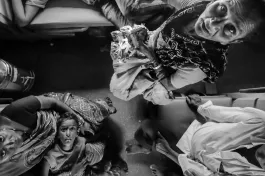As a long-term student of India’s welfare state and passionate advocate for a deeper and more substantive welfare regime, I have long been dissatisfied with the contours of our public debates on the contemporary welfare state in India. Those who speak up for welfare (mea culpa) largely frame the argument in terms of what India has failed to do. 'India is broken' (to borrow the title of Ashok Mody’s provocative 2023 book), the argument goes. It is a state captured by elites who direct public resources to serve their interests at the expense of the masses.
The other side of the debate actively delegitimises welfare investments, viewing them as nothing but 'freebies', 'revdis (Prime Minister Narendra Modi’s contribution to the lexicon), or 'bribes' offered by avaricious politicians. Democracy is, in this view, partly culpable because it creates perverse incentives that have fuelled 'populist', profligate excesses. The more sophisticated version of this argument plays into the old, now largely debunked, myth of growth versus welfare as trade-offs. Redistributive welfare is a luxury that only a singular, Arjuna-like focus on growth affords. Welfare comes after growth. Remember the Amartya Sen vs Jagdish Bhagwati debate on economic policy (Bhattacharya 2013) that dominated media attention in the run-up to the 2014 election? There is no better illustration of the public debate on welfare in India than that.
Advancing our knowledge of ideas and constraints that have shaped India’s welfare trajectory is essential to advocating for change.
For those of us who have been in the trenches, this debate is deeply unsatisfactory. Broken as India may be, it has also been the home of innovative welfare policy that has shaped national and global policy. From the mid-day meals to the Mahatma Gandhi National Rural Employment Guarantee Act (MGNREGA) and even direct benefit transfers, India’s recalcitrant state has routinely been pushed and prodded to innovate in far-reaching ways. Indeed, the twin impulses of democratisation and economic change have generated a distinctive, albeit limited, welfare state regime that needs to be better understood.
Such an understanding is critical both to challenge orthodoxies of growth vs welfare that are so entrenched in India’s elite commentariat and policy circles, and perhaps, more importantly, to empower those who advocate for substantive welfare. Advancing our knowledge of ideas and constraints that have shaped India’s welfare trajectory is essential to advocating for change. We need to engage with the history of India’s welfare state, the context within which choices were made (and not made), and the path dependencies they generated.
This is why Louise Tillin’s new book Making India Work: The Development of Welfare in a Multi-Level Democracy is a significant contribution to the welfare discourse. Through meticulous archival research, tracing the history of the evolution of India’s welfare regime to the present, Tillin’s contribution brings to the fore the debates, the political imagination, and economic choices that shaped India’s welfare regime at critical historical junctures. This history ought to foreground contemporary debates.
Precocious welfare
Tillin begins her account by characterising India as a “precocious” welfare regime. Even for the careful observer, this reviewer included, this is an unexpected characterisation. But Tillin breaks ground by convincingly demonstrating that at critical historical junctures India made advances in welfare policy that deviated from trajectories followed by advanced industrial economies in Europe and the United States and even East Asian economies, thus adopting its own distinctive path to welfare.
Tillin’s most unique contribution comes from her intrepid archival research that led to unearthing the fascinating and hitherto under-researched account of the origins of India’s welfare regime, including, a little-known nugget about B.R. Ambedkar’s aborted effort to commission a dedicated Beveridge report for India authored by William Beveridge himself. Tillin begins her account with the first significant step India took towards a modern welfare state through the passage of the Employees State Insurance Act (ESI) in 1948. It provided benefits to employees and their dependents in cases of sickness, maternity, and employment injuries. It is rarely acknowledged in contemporary debates on India’s welfare that viewed from a comparative lens India was a trail blazer. As Tillin points out, India was unique in introducing social insurance at an early stage of industrialisation, in a context of labour abundance, well before the advent of mass democracy.
Tillin begins her account with the first significant step India took towards a modern welfare state through the passage of the Employees State Insurance Act in 1948.
Tillin’s account reveals how the growing industrial competition in pre-independence India led to the demand for a national minimum wage, to be implemented through a countrywide social insurance system. Ironically this also set limits on the possibilities for welfare. By prioritising protections for formal sector workers, a boundary was drawn between industrial workers protected by social insurance and the large swath of informal workers in rural areas. These distinctions continue to shape India’s welfare state even today.
The ESI was originally imagined as the foundation of a universal welfare state but this was foreclosed at its inception. Ambedkar, who was appointed Member for Labour on the Viceroy’s Executive Council in 1942 and thus played a pivotal role in shaping the welfare regime, chose to confine the debate to urban industrial workers. It was over differences on the scope of welfare policy that Ambedkar withdrew his invitation to Beveridge. Beveridge had a more expansive vision and refused to confine his report to industrial workers alone.
Ambedkar’s position, Tillin speculates, may have emerged from his belief that urban industrial centres were the principal sites of Dalit emancipation. Regardless, these choices meant that India effectively divorced the pursuit of sickness insurance for industrial workers from a national vision for public health specifically and universal welfare more broadly.
Over time, political imperatives further entrenched these divisions as India failed to arrive at a negotiated agreement about unemployment policy, and eventually over-protected formal workers by making exit impossible. Thus, by the late 1960s labour regulation had become rigid in ways that forestalled both growth of formal employment and the extension of social insurance to the broader working population. The terms of the negotiated bargain between the state and capital over labour protection thus broke down and remains so, even today.
I belabour this bit of Tillin’s account not just because I was fascinated by what I learnt but also because it so effectively illustrates the significance of her research. We need to study and engage with the history and context of the origins of India’s welfare to better understand the present. Once Tillin’s account takes us to the early years of nation building after 1947, we learn how the contours of the pre-independence choices get further entrenched as India adopts a capital-intensive, import-substituting industrialisation model of economic development. India's economic model did not prioritise job creation, leaving that responsibility to the welfare state. However, instead of viewing welfare as a way to build people’s capacity to work – through investments in education and health – the state framed it as a citizen’s “duty to work.” As a result, crucial investments in human development, especially in education and healthcare, were sidelined in policy-making.
Importantly, regional electoral competition pushed state governments, who emerged as innovators paving the way for a new national direction in welfare through non-employment based social assistance.
Tillin identifies two other crucial periods: the expansion of agrarian capitalism after the Green Revolution and the structural adjustment phase in the 1990s. In both these pivotal moments, intensified regional electoral competition, a hallmark of democratisation, compelled the state to address the consequences of these developments through welfare initiatives. This period was marked by persistent unemployment and widening inequality. Food subsidies and employment guarantee programmes emerged as the pillars of the welfare state.
Importantly, regional electoral competition pushed state governments, who emerged as innovators paving the way for a new national direction in welfare through non-employment based social assistance. Old age pensions and mid-day meals were state-led efforts that generated pressure for national adoption. Throughout the 2000s, India’s economic growth enabled the expansion of welfare programmes at the national level. During this period, India’s welfare system developed into what Tillin describes as a “commodifying with protection” model: one where welfare supports an economy dependent on informal workers, and where state-provided social assistance is their main source of security outside the market.
Broadening the gaze
Tillin’s historically rich account is relevant not just for students and advocates of welfare in India but also for global scholars of welfare and development. Classical welfare state literature developed largely in the 20th century Anglo-European experience is based on a set of assumptions – class formation, centralised state systems, full (formal) employment – that do not hold in large parts of the global south.
In these contexts, welfare regimes have evolved in response to persistent informality, inequality (spatial and class), complex patterns of urbanisation, variations in state capacity, and the very specific role of organised civil society (different from labour struggles of the 20th century), which have in different ways shaped the nature, form, and scale of welfare states. Understanding these “worlds of welfare” require a very different set of theoretical tools to the ones currently deployed. Making India Work offers global scholarship an important, much-needed starting point in this endeavour.
Stepping away from the detail, reading through Tillin’s account, I gleaned three distinct characteristics of India’s welfare regime that help us understand both the continuities and ruptures of the contemporary moment in India and beyond. As a provocation, I lay out here three characteristics of this new welfare state.
Democratisation and the pressures of electoral politics meant that the failure to generate jobs could not be ignored. India’s welfare regimes bore the burden.
First, the burden of unemployment. Twentieth century welfare states in the West were designed to support and be supported by full employment. Its conceptual core was decommodification vis-à-vis markets but with guaranteed full employment. Employment was at the heart of the development of India’s welfare state, but the welfare state eventually emerged as an outcome of a failure to achieve this goal. The relationship is more complex than previously understood.
In her introduction, Tillin explains that the book’s title, Making India Work, reflects the central challenge of employment generation, which has long influenced India’s welfare policies. The design and development of India’s welfare system has been shaped by how the country addressed this challenge at key points in its history. However, this account also brings to the fore the consequences of repeated policy choices that simply failed to generate sustainable employment for the masses on the “type” of welfare India pursued. Democratisation and the pressures of electoral politics meant that the failure to generate jobs could not be ignored. India’s welfare regimes bore the burden.
This is why welfare politics has always been skewed towards employment guarantee schemes and direct benefits rather on investments in human capital and public goods infrastructure. India’s dismal performance on public investments in health, education and even sanitation (Swachh Bharath Mission notwithstanding) is a testimony to this. Rather than an active enabler of India’s economic transformation, welfare has been designed as a means to “compensate” (to borrow from Rathin Roy’s framing of a compensatory state) for structural failures in the economy. In the contemporary moment, as the challenge of unemployment is reaching a crescendo, cash transfers delivered via the technology-fuelled direct benefit transfer model now dominate India’s welfare regime. The present is a continuation of the past. The most enduring feature of India’s welfare regime is that it has had to carry this historical burden of economic failure.
Second, federalism as the driver of welfare regimes. Classic welfare state literature focuses on the nation state as the unit of analysis. But as Tillin’s account highlights, federalism has created a context where multiple welfare regimes co-exist within the framework of a nation state, albeit often in unexpected ways.
Tillin draws on her expertise in federalism to demonstrate how the pulls and pressures of India’s unique brand of federalism pushed innovation and shaped the contours of India’s national welfare regime. On the one hand, the centripetal bias in India’s fiscal federal architecture helped prevent a competitive race to the bottom that characterise many federal systems. Yet, it often veered in the direction of over-centralisation as the centre controlled the purse strings.
An increasingly competitive electoral landscape helped overcame some of the limits of excessive centralisation to ensure that social coalitions at the sub-national level propelled some states to emerge as genuine innovators, pushing the boundaries of India’s welfare regimes. Much of the direction of national social policy from the 1970s onwards has been shaped by state governments breaking new ground. The mid-day meals, the social pensions, and even the employment guarantee scheme followed this trajectory.
In recent years, notably after the BJP’s 2019 electoral victory, state governments led by charismatic opposition leaders have replicated this model as a means to challenge the BJP’s electoral dominance.
Federalism continues to shape India’s welfare regime in the contemporary moment. However, its contours have changed. The adoption of carefully branded, technology-fuelled cash transfers as a means to centralise political attribution within the persona of the party leader was first experimented with at the national level by the Modi-led Bharatiya Janata Party (BJP) government. In my joint work with Neelanjan Sircar, I have characterised this model as techno-patrimonial welfare (Aiyar and Sircar 2024), which relies on using welfare to legitimise the authority of the leader and centralise power within his/her persona.
In recent years, notably after the BJP’s 2019 electoral victory, state governments led by charismatic opposition leaders have replicated this model as a means to challenge the BJP’s electoral dominance. Sircar and I show through survey data that in the 2024 general elections, state-level welfare cash transfer schemes successfully attenuated the structural welfarist advantage that the BJP enjoyed in previous elections (Aiyar and Sircar 2024). India has now entered a new era of competitive welfarism, driven this time round by a centralised model that state governments are replicating in innovative ways. Even in this era of political centralisation, multi-level electoral competition continues to shape India’s welfare regime.
Third, citizenship. The post-World War II European welfare states were designed with the aspiration of achieving full citizenship by placing social rights alongside civil and political rights. Independent India’s welfare regimes have at different moments been shaped by a very distinctive vision of citizenship that has deviated from this norm. The effort to usher in a new regime of expanded rights-based welfare, inspired by T.H Marshall’s notion of social rights, in the mid 2000s when the United Progressive Alliance was in power is well documented. This era of welfare legislation was foregrounded in a vision of rights-bearing citizens making direct welfare claims on the state.
What is less widely known is that during the Nehruvian era, welfare was not framed as a social right but as a duty of citizenship. As Tillin explains, the Nehruvian welfare state was built around a model of labour decommodification focused on increasing production. Central to this approach was the idea of a “duty to work,” where citizens were encouraged to dedicate themselves to hard work as a means of achieving self- emancipation and contributing to national development within a broader nation-building effort.
India’s welfare state has continuously evolved to respond to very specific political dynamics emerging from the intersection of work, federalism, and visions of citizenship.
In the contemporary moment, this vision of 'duty' has re-entered the welfare imagination. But in this vision citizens are cast as labharthis, recipients of welfare 'duty bound' to pursue their own 'work' and 'freedom' from poverty. The labharthi today is a passive recipient of state benevolence in the form of direct benefit transfers rather than an active, claim-making, right-bearing citizen. Shifting political imaginations of notions of citizenship are thus central to the design and form that welfare regimes have taken in India.
India’s welfare state has continuously evolved to respond to very specific political dynamics emerging from the intersection of work, federalism, and visions of citizenship. Each of these has shaped the design, nature, and indeed impact of welfare. Understandings these dynamics are crucial to advancing scholarship on welfare states.
In sum, Making India Work is a remarkable and deeply insightful account that sheds light on the ideas, principles, political imaginations, and realpolitik that have shaped India’s unique and distinctive path to building a welfare state. In particular, it advances our understanding of how continuities and changes in economic policy, federalism, and above all notions of citizenship have characterised India’s welfare state.
In so doing, Tillin’s work offers us the starting point of a new framework to study and theorise welfare in the 21st century. Making India Work is essential reading for scholars and students of welfare states in India and beyond. Above all, this must be read in India by our commentariat who in the court of public opinion have been far too quick to delegitimise essential welfare investments as 'freebies' and 'revdis'. The debate must now shift to asking deeper questions about our economy and democracy.
Yamini Aiyar is a senior visiting fellow at the Saxena Center for Contemporary Studies at the Watson Institute for International and Public Affairs, Brown University.









